Quick Hello From Our CEO
I invite you to explore the history of Jonestown Bank & Trust Co. through words and pictures in a wonderful piece created by Evelyn Isele, a prominent historian 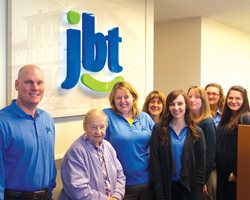 of Jonestown, PA. I approached Evelyn about recording our history in time for our 140th year celebration in 2014. She quickly produced this small booklet based on her own experiences in our community and Bank documents. We were delighted with the finished product. Evelyn passed away in April of 2016 at the age of 97, and this document stands as one of her last historical efforts. I hope you enjoy it!
of Jonestown, PA. I approached Evelyn about recording our history in time for our 140th year celebration in 2014. She quickly produced this small booklet based on her own experiences in our community and Bank documents. We were delighted with the finished product. Evelyn passed away in April of 2016 at the age of 97, and this document stands as one of her last historical efforts. I hope you enjoy it!
Troy A. Peters
JBT President & CEO
The Founding Years
When the Leba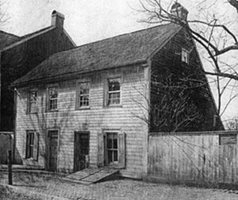 non Valley was purchased in September, 1732, from the Lenape “Delaware” Indians, the land was covered by many trees. Recently I read in an article about a man who left Lebanon and hiked through the mountains, came into Jonestown where he found a long wooden bridge across the Swatara Creek. Looking into the town, he saw a few log homes and a church on the hill. When the homes were built, all that a family needed was an ax. So, there was no monetary exchange of goods, it was all barter.
non Valley was purchased in September, 1732, from the Lenape “Delaware” Indians, the land was covered by many trees. Recently I read in an article about a man who left Lebanon and hiked through the mountains, came into Jonestown where he found a long wooden bridge across the Swatara Creek. Looking into the town, he saw a few log homes and a church on the hill. When the homes were built, all that a family needed was an ax. So, there was no monetary exchange of goods, it was all barter.
By 1792, a mint and standard coins was passed and in 1861 Congress passed an act to print legal tender paper money. So by 1873, our founding fathers organized the Jonestown Bank. It was chartered as a state bank May 17, 1873. A new charter enabled the bank to do fiduciary business and changed the name to the Jonestown Bank and Trust Company, issued May 10, 1928. At the time in the organization, the bank had a capital stock amounting to $50,000. Organizers of the bank were as follows: William H. Kaufman, David Rank, C.P. Miller, W.E. Brunner, Henry Bross, Thomas Lesher, Henry Heilman, Christian Lentz, Jeremiah Heilman, E.J. Freichler, John Philips, John C. Seltzer, Jerome W. Henry, Robert Bland, T.H. Brunner, Jacob G. Heilman. The first officers of the bank were William Brunner, President; David Rank, Vice President; H. Ulrich Heilman, teller and Jerome W. Henry, cashier.
JBT Continues To Grow
There was a tim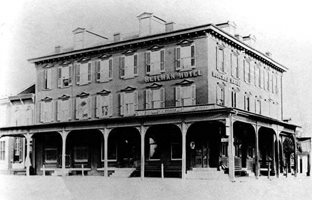 e in the early days of the town that Jonestown had the only bank in that section of Lebanon County. The nearest banks in those days were in the city of Lebanon and in Pine Grove to the north. Today, the Jonestown Bank is one of the most flourishing banking institutions in Lebanon County.
e in the early days of the town that Jonestown had the only bank in that section of Lebanon County. The nearest banks in those days were in the city of Lebanon and in Pine Grove to the north. Today, the Jonestown Bank is one of the most flourishing banking institutions in Lebanon County.
The first stock certificate was issued to Daniel Yerger – 10 shares in 1873. The first location of the bank was a two story home in the square. The east side was a general store occupied by William Zehring known as Old Bimble. The west side had been a tavern run by Mrs. Peters who was known for her lager beer and pretzels. It was on the west side that the bank opened their doors.
By 1880, the room had gotten too small and they moved across the square to the Heilman Hotel where the ABC Laundromat is currently located. The bank’s first location was torn down and the Jonestown Borough Hall was built in its place in 1915.
Heists In Our History
On April 2, 1931, the first bank robbery of Lebanon County took place at the Jonestown Bank in the square. Thirteen year old Truman Young, who lived across the street, was returning to school after having lunch at home. When he passed the bank, a man in a green Oldsmobile that had been stolen in Ohio, told him to “scram.” He later identified the driver as Carl Schearer, 20 years old from Ohio. Richard Winklebleck, a local man who had gone to Ohio ten years prior, was the brains behind the operation. Donald Boeshore, age 19 of Lebanon and Albert Walsh, age 21 were the other culprits. They had been schoolmates prior to this. They entered the bank with sawed off shotguns and revolvers. Using copper wire, they tied up Harry Huldaman the trust officer, Clayton Boltz the cashier and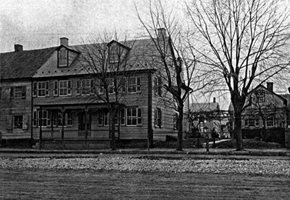 Henry Lesher who had just returned from lunch. Amy Loser, who worked as a telephone operator across the street on the top floor across from Mohn’s Hardware Store, was returning from lunch and saw what was happening. She called Frank Miller, our town constable who, in turn, called the State Police who were stationed in Lebanon. Ray Wood and his son Clifford, who lived on East Market Street, were down in the square on business. They saw the getaway car turn around, almost upsetting, and followed them in their car to Greble Road on the east end of town, where one of the robbers leaned out of the car and scattered roofing nails on the road so that they couldn’t be followed. In those days, the tires were much narrower and had inner tubes. They crossed Route 343 and got to Moyer’s Cemetery, later called Brightbill’s. They changed to a Ford Cabriolet, a car that was parked under the roof where the horses are kept for Sunday church service. They were eventually captured in Ohio. The bank robbers netted $6,000 in cash and $5,000 in gold, but most of it was recovered. Carl Shearer was shot in Ohio when resisting arrest. He later died from his injuries. Boeshore and Walsh both received jail sentences. Lebanon Daily News claimed that they could receive 10 to 20 years. Winklebleck paid the price of 25 years in the penitentiary, and then came back to Lebanon to live. He died in 1979, and is buried at the Lutheran Cemetery in Jonestown.
Henry Lesher who had just returned from lunch. Amy Loser, who worked as a telephone operator across the street on the top floor across from Mohn’s Hardware Store, was returning from lunch and saw what was happening. She called Frank Miller, our town constable who, in turn, called the State Police who were stationed in Lebanon. Ray Wood and his son Clifford, who lived on East Market Street, were down in the square on business. They saw the getaway car turn around, almost upsetting, and followed them in their car to Greble Road on the east end of town, where one of the robbers leaned out of the car and scattered roofing nails on the road so that they couldn’t be followed. In those days, the tires were much narrower and had inner tubes. They crossed Route 343 and got to Moyer’s Cemetery, later called Brightbill’s. They changed to a Ford Cabriolet, a car that was parked under the roof where the horses are kept for Sunday church service. They were eventually captured in Ohio. The bank robbers netted $6,000 in cash and $5,000 in gold, but most of it was recovered. Carl Shearer was shot in Ohio when resisting arrest. He later died from his injuries. Boeshore and Walsh both received jail sentences. Lebanon Daily News claimed that they could receive 10 to 20 years. Winklebleck paid the price of 25 years in the penitentiary, and then came back to Lebanon to live. He died in 1979, and is buried at the Lutheran Cemetery in Jonestown.
Jonestown Bank experienced two more robberies since the first one occurred in 1931. On March 5, 1998, James Cosgrove of Cresapto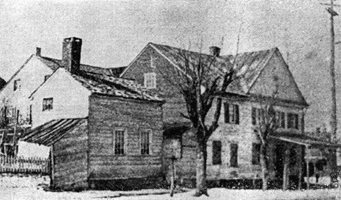 wn and in 2012 a woman dressed as a man, Jasmine McDaniel robbed or attempted to rob Jonestown Bank. The Christian Seltzer home stood in the location of the current Jonestown Bank for many years. Reformed Church Parsonage stood beside the Christian Seltzer home. To the right is where the bank drive-up window is now located. 5 On the corner of Market and South Lancaster Streets stood the house of Christian Seltzer. He and his understudy, Peter Rank made the famous Dower Chest. The bank bought the property in 1934, tore down the house along with the reformed church parsonage occupied by Rev. Brendle and built the present bank which was constructed for $25,000. In 1955, a first addition was built for $60,000. Then the bank bought the reformed parsonage for $15,000 and the Earnest property in 1969 for $7,250. A second addition was built for $98,900.
wn and in 2012 a woman dressed as a man, Jasmine McDaniel robbed or attempted to rob Jonestown Bank. The Christian Seltzer home stood in the location of the current Jonestown Bank for many years. Reformed Church Parsonage stood beside the Christian Seltzer home. To the right is where the bank drive-up window is now located. 5 On the corner of Market and South Lancaster Streets stood the house of Christian Seltzer. He and his understudy, Peter Rank made the famous Dower Chest. The bank bought the property in 1934, tore down the house along with the reformed church parsonage occupied by Rev. Brendle and built the present bank which was constructed for $25,000. In 1955, a first addition was built for $60,000. Then the bank bought the reformed parsonage for $15,000 and the Earnest property in 1969 for $7,250. A second addition was built for $98,900.
In 1957, they added a drive-in window on the corner of Market and Lancaster Streets. A World War II monument stood in the location of the current drive-in window, dedicated to all of those men and women from Jonestown, Swatara Township, Union Township, East Hanover Township and Cold Springs that served their country.
Moving Forward
In 1928, the capital was increased to $125,000 and received a new charter to do Trust business. Then the name was changed to the Jonestown Bank and Trust Company. In 1934 the capital was $120,000, surplus $300,000, undivided profits were $108,769.54. Reserves were $40,351.83. Demand deposits were $1,327,020.13. Timed deposits were $2,700,585.64. The trust fund was $277,955.37 and the corporate trust fund was $375,000.
Board Of Directors And Officers
1934 Board of Directors
Jacob K. Light, Paul D. Reich, John A. Schock, Isaac Deck, George A. Speck, H. Ross Rank, Raymond J. Emrich, Alfred J. Wolfe
1934 Officers
Jacob. K. Light, President Paul D. Reich, Vice President John A. Schock, Secretary Clayton R. Boltz, Treasurer Henry B. Lesher, Assistant Treasurer Harry J. Haldeman, Trust Officer
1961 Board of Directors
Wayne L. Sholly, Harvey K. Light, Clarence B. Dillman, Jonas P. Donmoyer, Raymond J. Emrich, Warren P. Kleinfelter, Raymond Maulfair, Frank A. Shuey
1961 Officers
Wayne L. Sholly, President, Harvey K. Light, Vice President, Clarence B. Dillman, Secretary, Clayton R. Boltz, Treasurer, George S. Spotts, Asst. Treasurer & Trust Officer, Frederick R. Boltz, Asst. Trust Officer, Grace E. Swanger, Bookkeeper, Florence E. Gahres, Bookkeeper, Kathryn Long, Teller, Albert Maurer, Teller, Nancy L. Shuey, Teller, Elsie Kettering, Teller, Anna Mae Shirk, Teller